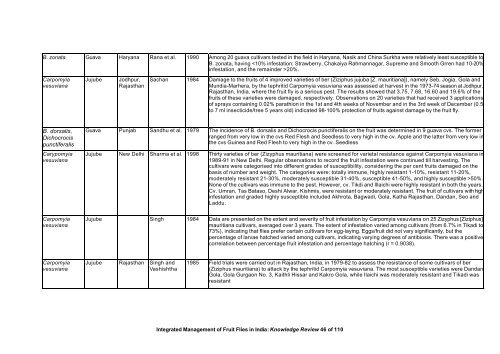“Key Informant Survey” of Production, Value, Losses and ... - DfID
“Key Informant Survey” of Production, Value, Losses and ... - DfID
“Key Informant Survey” of Production, Value, Losses and ... - DfID
Create successful ePaper yourself
Turn your PDF publications into a flip-book with our unique Google optimized e-Paper software.
B. zonata Guava Haryana Rana et al. 1990 Among 20 guava cultivars tested in the field in Haryana, Nasik <strong>and</strong> China Surkha were relatively least susceptible to<br />
B. zonata, having 20%.<br />
Carpomyia<br />
vesuviana<br />
B. dorsalis,<br />
Dichocrocis<br />
punctiferalis<br />
Carypomyia<br />
vesuviana<br />
Carpomyia<br />
vesuviana<br />
Carpomyia<br />
vesuviana<br />
Jujube Jodhpur,<br />
Rajasthan<br />
Sachan 1984 Damage to the fruits <strong>of</strong> 4 improved varieties <strong>of</strong> ber (Ziziphus jujuba [Z. mauritiana]), namely Seb, Jogia, Gola <strong>and</strong><br />
Mundia-Marhera, by the tephritid Carpomyia vesuviana was assessed at harvest in the 1973-74 season at Jodhpur,<br />
Rajasthan, India, where the fruit fly is a serious pest. The results showed that 3.75, 7.68, 16.60 <strong>and</strong> 19.6% <strong>of</strong> the<br />
fruits <strong>of</strong> these varieties were damaged, respectively. Observations on 20 varieties that had received 3 applications<br />
<strong>of</strong> sprays containing 0.02% parathion in the 1st <strong>and</strong> 4th weeks <strong>of</strong> November <strong>and</strong> in the 3rd week <strong>of</strong> December (0.5<br />
to 7 ml insecticide/tree 5 years old) indicated 98-100% protection <strong>of</strong> fruits against damage by the fruit fly.<br />
Guava Punjab S<strong>and</strong>hu et al. 1979 The incidence <strong>of</strong> B. dorsalis <strong>and</strong> Dichocrocis punctiferalis on the fruit was determined in 9 guava cvs. The former<br />
ranged from very low in the cvs Red Flesh <strong>and</strong> Seedless to very high in the cv. Apple <strong>and</strong> the latter from very low in<br />
the cvs Guinea <strong>and</strong> Red Flesh to very high in the cv. Seedless<br />
Jujube New Delhi Sharma et al. 1998 Thirty varieties <strong>of</strong> ber (Zizyphus mauritiana) were screened for varietal resistance against Carpomyia vesuviana in<br />
1989-91 in New Delhi. Regular observations to record the fruit infestation were continued till harvesting. The<br />
cultivars were categorised into different grades <strong>of</strong> susceptibility, considering the per cent fruits damaged on the<br />
basis <strong>of</strong> number <strong>and</strong> weight. The categories were: totally immune, highly resistant 1-10%, resistant 11-20%,<br />
moderately resistant 21-30%, moderately susceptible 31-40%, susceptible 41-50%, <strong>and</strong> highly susceptible >50%.<br />
None <strong>of</strong> the cultivars was immune to the pest. However, cv. Tikdi <strong>and</strong> Illaichi were highly resistant in both the years.<br />
Cv. Umran, Tas Bataso, Deshi Alwar, Kishmis, were resistant or moderately resistant. The fruit <strong>of</strong> cultivars with high<br />
infestation <strong>and</strong> graded highly susceptible included Akhrota, Bagwadi, Gola, Katha Rajasthan, D<strong>and</strong>an, Seo <strong>and</strong><br />
Laddu.<br />
Jujube Singh 1984 Data are presented on the extent <strong>and</strong> severity <strong>of</strong> fruit infestation by Carpomyia vesuviana on 25 Zizyphus [Ziziphus]<br />
mauritiana cultivars, averaged over 3 years. The extent <strong>of</strong> infestation varied among cultivars (from 6.7% in Tikadi to<br />
73%), indicating that flies prefer certain cultivars for egg-laying. Eggs/fruit did not vary significantly, but the<br />
percentage <strong>of</strong> larvae hatched varied among cultivars, indicating varying degrees <strong>of</strong> antibiosis. There was a positive<br />
correlation between percentage fruit infestation <strong>and</strong> percentage hatching (r = 0.9038).<br />
Jujube Rajasthan Singh <strong>and</strong><br />
Vashishtha<br />
1985 Field trials were carried out in Rajasthan, India, in 1979-82 to assess the resistance <strong>of</strong> some cultivars <strong>of</strong> ber<br />
(Ziziphus mauritiana) to attack by the tephritid Carpomyia vesuviana. The most susceptible varieties were D<strong>and</strong>an<br />
Gola, Gola Gurgaon No. 3, Kaithli Hissar <strong>and</strong> Kakro Gola, while Ilaichi was moderately resistant <strong>and</strong> Tikadi was<br />
resistant<br />
Integrated Management <strong>of</strong> Fruit Flies in India: Knowledge Review 46 <strong>of</strong> 110

















